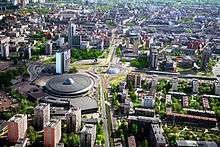Upper Silesian metropolitan area
The Upper Silesian metropolitan area is a metropolitan area in southern Poland and northeast Czech Republic, centered on the cities of Katowice and Ostrava in Silesia. Located in the three administrative units (NUTS-2 class): mainly Silesian Voivodeship, a small western part of Lesser Poland Voivodeship and a small east part of Moravian-Silesian Region.
Upper Silesian metropolitan area obszar metropolitalny konurbacji górnośląskiej Slezská Metropolitní oblast | |
|---|---|
 | |
| Country | Poland, Czech Republic |
| Region | Mainly Silesia |
| Largest Cities | Katowice Ostrava Sosnowiec Gliwice Zabrze Bytom |
| Area | |
| • Metro | 5,400 km2 (2,100 sq mi) |
| Population | |
| • Metro | 5,294,000 |
| • Metro density | 980/km2 (2,500/sq mi) |
| Time zone | UTC+1 (CET) |

The area lies within the Upper Silesian Coal Basin. Silesian metropolitan area (5.3 million people) with nearby Kraków metropolitan area (1.3 million[1][2][3][4][5] people) and Częstochowa metropolitan area (0.4 million[1][2][3] people) create a great metropolitan area covering 7 million people.
Statistics
Upper Silesian metropolitan area has a population of 5,294,000, with 4,311,000 (81.43%) in Poland (the Upper Silesian polycentric metropolitan area) and 983,000 (18.57%) in the Czech Republic (Ostrava Functional Urban Area).[1] According to Polish Scientific Publishers (PWN) area is 5,400 km², with 4,500 km² (83.33%) in Poland and 900 km² (16.67%) in the Czech Republic.[6] According to the Brookings Institution, area has a population of 5,008,000.[7]
The area consists of several Functional Urban Areas (FUA), each of which is defined as a core Morphological Urban Area (MUA) based on population density plus the surrounding labour pool, i.e. a metropolitan area. This area contains the following FUAs:[1]
- Katowice FUA: 3,029,000 (see also Katowice urban area); within Upper Silesian Industrial Region
- Bielsko-Biała FUA and Cieszyn FUA: 647,000 (584,000 + 63,000); within north of Cieszyn Silesia and Bielsko Industrial Region
- Rybnik FUA, Wodzisław Śląski and Racibórz FUA: 634,000 (526,000 + 109,000); within Rybnik Coal Area
- Ostrava FUA: 983,000; within Ostrava-Karviná Coal Area
Data may vary depending on the source, example for same the Katowice city exist sources for 3.5 million people;[8][9] for the Rybnik – 507,000,[3] while for the Ostrava – 1,153,876.[2]
Economy
Historically, most of the area was characterized by heavy industry since the age of industrialisation in the late 19th and early 20th century. In addition to coal, Upper Silesia also contains a number of other minable resources (methane, cadmium, lead, silver and zinc). Resources of coal to a depth to 1000 meters – about 70 billion tons, the conditions for the extraction – good.[6]
See also
- Rhine-Ruhr
- Katowice urban area, part of the Upper Silesian metropolitan area
- Upper Silesian Industrial Region
- Silesian Metropolis, a political and economic association of local municipalities
References
- (in English) European Spatial Planning Observation Network (ESPON) "ESPON project 1.4.3. Study on Urban Functions" Archived 2015-09-24 at the Wayback Machine – Final report, March 2007, ISBN 2-9600467-2-2
- (in English) Eurostat, Urban Audit database Archived 2011-04-06 at the Wayback Machine, accessed on 2009-03-12. Data for 2004.
- (in Polish) "Społeczne i polityczne zróżnicowanie aglomeracji w Polsce" – Paweł Swianiewicz, Urszula Klimska Archived 2009-01-24 at the Wayback Machine; University of Warsaw 2005
- (in Polish) Funkcje Metropolitalne Pięciu Stolic Województw Wschodnich Archived 2009-03-27 at the Wayback Machine – Tadeusz Markowski
- (in Polish) "Koncepcja przestrzennego zagospodarowania kraju" Archived 2010-03-31 at the Wayback Machine – Ministry of Regional Development, 2003
- (in Polish) "Górnośląskie Zagłębie Węglowe" – PWN Encyclopedia
- "Redefining Global Cities". Brookings Institution.
- (in English) www.worldatlas.com
- (in Polish) "Górnośląski Okręg Przemysłowy" – PWN Encyclopedia
